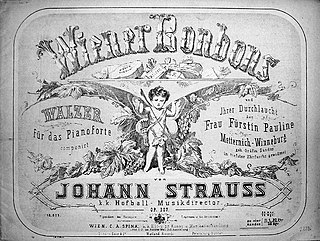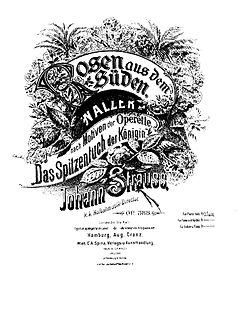Related Research Articles

"The Blue Danube" is the common English title of "An der schönen, blauen Donau", Op. 314, a waltz by the Austrian composer Johann Strauss II, composed in 1866. Originally performed on 15 February 1867 at a concert of the Wiener Männergesangsverein, it has been one of the most consistently popular pieces of music in the classical repertoire. Its initial performance was considered only a mild success, however, and Strauss is reputed to have said, "The devil take the waltz, my only regret is for the coda—I wish that had been a success!"

Wiener Bonbons op. 307 is a waltz by Johann Strauss II written in 1866. It was first performed on 28 January 1866 at the ball of the Association of Industrial Societies held in the Redoutensaal and was dedicated to the influential Princess Pauline Metternich-Winneburg the wife of then Austrian ambassador to Paris.
Liebeslieder op. 114 is a waltz by Johann Strauss II written in 1852. At the time it was conceived, the waltz was titled 'Liebesgedichte' or "Love Poems" and during its first performance, it was even announced as 'Liebesständchen' or "Love Serenade". The first performance was at the famed Vienna Volksgarten on 18 June 1852 under the composer's direction.
Cagliostro-Walzer op.370 is a waltz by Johann Strauss II composed in 1875 based on themes from his operetta, Cagliostro in Wien which premiered on 27 February 1875 at the famous Theater an der Wien.

Rosen aus dem Süden, Op. 388, is a waltz medley composed by Johann Strauss II in 1880 with its themes drawn from the operetta Das Spitzentuch der Königin inspired by a novel by Heinrich Bohrmann-Riegen.
Künstlerleben, Op. 316 is a waltz written by Johann Strauss II in 1867, following closely on the success of the popular "The Blue Danube". Austria was severely shaken the previous year 1866 by the crushing defeat that the Austrian army suffered in the Battle of Königgrätz and many of the year's festivities and balls were cancelled as the prevalent depressing mood affected most of Vienna's populace.
Immer heiterer op. 235 is a waltz written by Johann Strauss II in 1860 for the Vienna Carnival Fasching. The waltz was marked as "im ländlerstil" which meant that it was to be performed in the same style as the ländler.

Nordseebilder op. 390 is a waltz by Johann Strauss II composed in 1879.
Morgenblätter op. 279 is a Viennese Waltz composed by Johann Strauss II in 1863. The work's genesis was attributed to the composition of another waltz by Jacques Offenbach later titled 'Abendblätter' when the French opera composer dedicated his work to the influential Vienna Authors' and Journalists' Association ('Concordia'). The Association had earlier intended the 'Abendblätter' waltz to be played at their 'Concordia Ball' on 12 January 1864.

Wiener Blut Op. 354 is a waltz by Johann Strauss II first performed by the composer on 22 April 1873. The new dedication waltz was to celebrate the wedding of the Emperor Franz Joseph I's daughter Archduchess Gisela Louise Maria and Prince Leopold of Bavaria. However, the waltz was also chiefly noted by Strauss' biographers as the début of Strauss with the Vienna Philharmonic Orchestra where for many years, the Philharmonic had dismissed any association with the 'Waltz King' as it had not wished to be associated with mere 'light' or 'pops' music. The festival ball celebrating the event was held at the Musikverein Hall which is the venue for the present day Neujahrskonzert.
Karnevalsbotschafter op. 270 is a waltz composed by Johann Strauss II in the autumn of 1862. Incidentally, it was also written during Strauss' honeymoon with his first wife Henrietta Treffz in Venice. It was first performed at the 50th anniversary celebration of the Vienna's Gesellschaft der Musikfreunde at the 'Sperl' dance hall on 11 November 1862 and also at a soirée there on 22 November. The title may be alluded to Strauss himself, as a 'carnival ambassador' to Venice having accomplished the year's Fasching festivity commitments in Vienna. Unsurprisingly for him in Venice, although his wife had intended the honeymoon as a complete rest for him, he found himself duly inspired to pen this lovely waltz in a period of great personal happiness.
"Frühlingsstimmen", Op. 410 is an orchestral waltz, with optional solo soprano voice, written in 1882 by Johann Strauss II.
Vergnügungszug op. 281 is a polka composed by Johann Strauss II in 1864. It was written for the Association of Industrial Societies' Ball held in the Redoutensaal on 19 January 1864 and was inspired by the opening of the Austrian Southern Railway – the Südbahn – which operated many 'pleasure trains' offering trips from Vienna to the countryside.
Schatz-Walzer op. 418 is a Viennese Waltz by Johann Strauss II composed in 1885. The melodies from this waltz were drawn from Strauss' operetta Der Zigeunerbaron which premiered to critical acclaim on 24 October 1885.
Flugschriften ('Pamphlets') op. 300 is a waltz by Johann Strauss II written in 1865 and first performed on 17 January 1866 at the Habsburg Court Ball in the Rittersaal of the Imperial Hofburg Palace graced by the Emperor Franz Josef and Empress Elisabeth. The waltz had earlier been intended to be dedicated for the occasion of the annual ball of the Vienna Authors' and Journalists' Association 'Concordia' ball held at the Sofienbad-saal ballroom on 21 January 1866.
Studentenlust op. 285 is a waltz by Johann Strauss II composed in 1864. The waltz was written as a dedication piece for the Students' Ball held in the Redoutensaal of the Imperial Hofburg Palace on 31 January of that year.
Illustrationen (Illustrations) op. 331 is a waltz by Johann Strauss II composed in 1869. It was appropriately titled for the annual ball of the Vienna Journalists' and Authors' Association ('Concordia') that was held in the Sofienbad Saal on 26 January the same year.
Leitartikel op. 273 is a waltz composed by Johann Strauss II in 1863 and first performed at the Vienna's Artists and Journalists' Association ball called 'Concordia', which glorifies the Roman goddess of civic harmony, on 19 January 1863. Theoretically, this work would have been Strauss' only contribution towards the festivity of Vienna's Fasching of that year as his health did not permit laborious hours of conducting nor of composing.

"Tales from the Vienna Woods" is a waltz by Johann Strauss II.
Farewell to America is the name of a waltz composed by Johann Strauss II. In the immediate wake of the composer's visit to the United States in the summer of 1872, when he conducted several times in Boston and New York, no less than seven publishers issued waltzes supposedly composed by Strauss. Only two from the total of nine compositions that were published are known to have been performed by Strauss during his tour of the United States: the Jubilee Waltz and the Manhattan Waltzes. It is unknown whether or not the other compositions that were published were written by Strauss while he was in America, completed by him after his return to Vienna and sent through the mail, or that some of the publications had nothing to do with Strauss himself, but were compiled by publishers anxious to benefit from Strauss' American tour and the clamour for new Strauss music.
References
Based on original text by Peter Kemp, The Johann Strauss Society of Great Britain. Used with permission.